Matrix metalloproteinase-dependent microsomal prostaglandin E synthase-1 expression in macrophages: role of TNF-α and the EP4 prostanoid receptor
- PMID: 22227567
- PMCID: PMC3273587
- DOI: 10.4049/jimmunol.1102383
Matrix metalloproteinase-dependent microsomal prostaglandin E synthase-1 expression in macrophages: role of TNF-α and the EP4 prostanoid receptor
Erratum in
-
Correction: Matrix Metalloproteinase-Dependent Microsomal Prostaglandin E Synthase-1 Expression in Macrophages: Role of TNF-α and the EP4 Prostanoid Receptor.J Immunol. 2021 Jul 15;207(2):746-747. doi: 10.4049/jimmunol.2100445. Epub 2021 Jul 2. J Immunol. 2021. PMID: 34215658 No abstract available.
Abstract
Matrix metalloproteinase (MMP)-9 contributes to the pathogenesis of chronic inflammatory diseases and cancer. Thus, identifying targetable components of signaling pathways that regulate MMP-9 expression may have broad therapeutic implications. Our previous studies revealed a nexus between metalloproteinases and prostanoids whereby MMP-1 and MMP-3, commonly found in inflammatory and neoplastic foci, stimulate macrophage MMP-9 expression via the release of TNF-α and subsequent induction of cyclooxygenase-2 and PGE(2) engagement of EP4 receptor. In the current study, we determined whether MMP-induced cyclooxygenase-2 expression was coupled to the expression of prostaglandin E synthase family members. We found that MMP-1- and MMP-3-dependent release of TNF-α induced rapid and transient expression of early growth response protein 1 in macrophages followed by sustained elevation in microsomal prostaglandin synthase 1 (mPGES-1) expression. Metalloproteinase-induced PGE(2) levels and MMP-9 expression were markedly attenuated in macrophages in which mPGES-1 was silenced, thereby identifying mPGES-1 as a therapeutic target in the regulation of MMP-9 expression. Finally, the induction of mPGES-1 was regulated, in part, through a positive feedback loop dependent on PGE(2) binding to EP4. Thus, in addition to inhibiting macrophage MMP-9 expression, EP4 antagonists emerge as potential therapy to reduce mPGES-1 expression and PGE(2) levels in inflammatory and neoplastic settings.
Figures

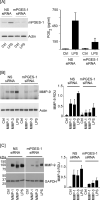
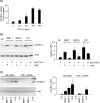


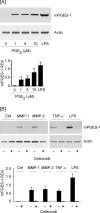
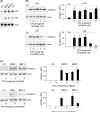
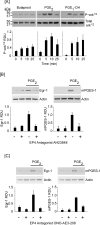
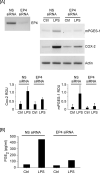


Similar articles
-
Matrix metalloproteinase (MMP)-1 and MMP-3 induce macrophage MMP-9: evidence for the role of TNF-alpha and cyclooxygenase-2.J Immunol. 2009 Dec 15;183(12):8119-27. doi: 10.4049/jimmunol.0901925. J Immunol. 2009. PMID: 19923455 Free PMC article.
-
Association between prostaglandin E receptor subtype EP4 overexpression and unstable phenotype in atherosclerotic plaques in human.Arterioscler Thromb Vasc Biol. 2005 Sep;25(9):1925-31. doi: 10.1161/01.ATV.0000177814.41505.41. Epub 2005 Jul 14. Arterioscler Thromb Vasc Biol. 2005. PMID: 16020747
-
Targeting prostaglandin E2 receptors as an alternative strategy to block cyclooxygenase-2-dependent extracellular matrix-induced matrix metalloproteinase-9 expression by macrophages.J Biol Chem. 2006 Feb 10;281(6):3321-8. doi: 10.1074/jbc.M506846200. Epub 2005 Dec 7. J Biol Chem. 2006. PMID: 16338931
-
Aspirin inhibits MMP-9 mRNA expression and release via the PPARalpha/gamma and COX-2/mPGES-1-mediated pathways in macrophages derived from THP-1 cells.Biomed Pharmacother. 2010 Feb;64(2):118-23. doi: 10.1016/j.biopha.2009.04.033. Epub 2009 Oct 17. Biomed Pharmacother. 2010. PMID: 19880272
-
Pharmacological modulation of plaque instability.Lupus. 2005;14(9):769-72. doi: 10.1191/0961203305lu2218oa. Lupus. 2005. PMID: 16218485 Review.
Cited by
-
The prostaglandin E2 receptor EP4 is integral to a positive feedback loop for prostaglandin E2 production in human macrophages infected with Mycobacterium tuberculosis.FASEB J. 2013 Sep;27(9):3827-36. doi: 10.1096/fj.13-228858. Epub 2013 Jun 12. FASEB J. 2013. PMID: 23759445 Free PMC article.
-
Identifying the Involvement of Pro-Inflammatory Signal in Hippocampal Gene Expression Changes after Experimental Ischemia: Transcriptome-Wide Analysis.Biomedicines. 2021 Dec 5;9(12):1840. doi: 10.3390/biomedicines9121840. Biomedicines. 2021. PMID: 34944656 Free PMC article.
-
A representative metalloprotease induces PGE2 synthesis in fibroblast-like synoviocytes via the NF-κB/COX-2 pathway with amplification by IL-1β and the EP4 receptor.Sci Rep. 2020 Feb 24;10(1):3269. doi: 10.1038/s41598-020-59095-z. Sci Rep. 2020. PMID: 32094439 Free PMC article.
-
A Representative GIIA Phospholipase A2 Activates Preadipocytes to Produce Inflammatory Mediators Implicated in Obesity Development.Biomolecules. 2020 Nov 24;10(12):1593. doi: 10.3390/biom10121593. Biomolecules. 2020. PMID: 33255269 Free PMC article.
-
IL-6-mediated induction of matrix metalloproteinase-9 is modulated by JAK-dependent IL-10 expression in macrophages.J Immunol. 2014 Jan 1;192(1):349-57. doi: 10.4049/jimmunol.1301906. Epub 2013 Nov 27. J Immunol. 2014. PMID: 24285838 Free PMC article.
References
-
- Nagase H, Okada Y. Proteinases and Matrix Degradation. In: Kelly WN, Harris ED Jr., Ruddy S, Sledge CB, editors. The Textbook of Rheumatology. 5 ed. W.B.Saunders; Philadelphia: 1996. pp. 323–341.
-
- Opdenakker G, Van den Steen PE, Van Damme J. Gelatinase B: a tuner and amplifier of immune functions. Trends in Immunology. 2001;22:571–579. - PubMed
-
- Parks WC, Wilson CL, Lopez-Boado YS. Matrix metalloproteinases as modulators of inflammation and innate immunity. Nature Reviews Immunology. 2004;4:617–629. - PubMed
Publication types
MeSH terms
Substances
Grants and funding
LinkOut - more resources
Full Text Sources
Medical
Molecular Biology Databases
Research Materials
Miscellaneous

